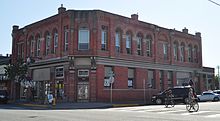A Crow Looked at Me
His sparse lyrics and minimalistic musical accompaniment drew influence from a broad range of artists, including the poet Gary Snyder, author Karl Ove Knausgård and songwriter Julie Doiron.
Characterized by lo-fi production and loose instrumentation, A Crow Looked at Me departs from Elverum's earlier and more complex experimental works, but is musically similar to his album Lost Wisdom (2008).
Phil Elverum's wife, the Canadian cartoonist and musician Geneviève Castrée, was diagnosed with pancreatic cancer in 2015, four months after the birth of their first child.
[2] Inspired by Gary Snyder's poem "Go Now", Elverum realized that he did not have to take meaning from Castrée's death, and could write frank songs that bluntly describe her illness and his experience.
[20] Elverum was compelled to make the album having found that works of art he once had treasured were ineffective in helping him cope with her illness and death.
[6] Stereogum writer Patrick Lyons speculated that the comic's appearance served as a connection to Elverum's following album, Now Only, which has a song titled "Tintin in Tibet".
[27] The photograph shows Elverum's hand holding a piece of paper with the poem "Night Palace" by Castrée's close friend Joanne Kyger.
"[The songs] suggest what it might be like to look at a person but, instead of seeing their clothes and skin, gazing directly upon their strained muscles, their nerves firing sparks, their blood frantically coursing through their arteries, and understand just how fragile the whole damn thing is.
[32] Paste's Matt Fink suggested that although Elverum's repertoire of songs about mortality is perhaps second only to those about nature, A Crow Looked at Me "marks the first time he has written about death".
[33] The work's exploration of death has been compared to the Antlers' Hospice (2009), David Bowie's Blackstar (2016) and Sufjan Stevens's Carrie & Lowell (2015), although, as highlighted by writer Isabel Zacharias, A Crow Looked at Me focuses more on the grieving process and its mundane aspects than these albums do.
[13] Thomas Britt of PopMatters highlighted this element, writing that the approach made real the impact of death on continuing, everyday life.
[35] The songs, with the exception of the closer "Crow"—which is addressed to the couple's daughter, whose role in the album's story is almost that of a second protagonist—refer to Castrée, although she is never directly named.
[40] According to The New Yorker's Peter Baker, the album's lyrics combine "emotional intimacy and tonal frankness to a degree rarely heard in contemporary music".
[41] The Guardian's Brigid Delaney wrote that the album is more comparable to "a traditional lament" than popular pieces of music about death such as Nick Cave and the Bad Seeds' Skeleton Tree.
[42] The New York Times's Jon Caramanica wrote that "songwriting seems almost too precise a term" because "the line is blurred between singing, speaking and raw emotional data dump".
[47] The simplicity of the songs reflects Elverum's wish to move away from his earlier, more "artistically challenging" work, which is characterized by "harsh tones" and "complicated chords".
[18] Jayson Greene of Pitchfork explained the contrast to Elverum's earlier work as similar to "the difference between charting a voyage around the earth and undertaking it".
[17] "Swims" details his experience of grief counseling and the sudden death of his counselor; his vocals are accompanied by a minimal guitar line and simple piano chords.
[9] Britt wrote that the song's introspection makes previous dark, brooding moods in Elverum's work seem enjoyable by comparison.
[43] During the same track, Elverum uses a drum kit to simulate the sound of a closing door to recall a moment when he took out Castrée's trash.
[61] The final song, "Crow", is addressed to Elverum's daughter and recounts their hiking trip in the Pacific Northwest when they were followed by a bird that seems to personify Castrée.
[67] The concert publicity generated significant interest; as a result, Elverum asked for attendance of less than 50, the amount the venue was capable of holding.
Music critic Eric Grandy described the performance as "heavy and awkward and weird" yet "supportive and cathartic and necessary", taking into account the crowd's emotional reaction to the material.
[71][72] He spoke to numerous press outlets while promoting the album but said these experiences were more akin to talk therapy than to a typical public relations campaign.
[86] Elverum experienced nightmares in the lead up to touring the songs live until he gained confidence from the early positive reactions of friends and family.
[101] Tiny Mix Tapes' writer Jessie Rovinelli said that the album "recommitted me to the world as it is, reminded me of the danger of grand statements and the sad comfort in uncertainty".
[103] Andy O'Connor, in an article for Spin, noted that the album was widely praised and "identified with" because of the perceived ubiquity of grief in the late 2010s.
[131] Both Ben Hansen of Happy Mag and Britt hold it as the peak of the Mount Eerie project, the latter going further and saying it concluded "Elverum's longtime preoccupations ... with nature and death".
[132] According to Max Savage Levenson of Bandcamp Daily, by the end of 2017, the album had been recognized as a "milestone" in Elverum's career; Tiny Mix Tapes writer, Leah B. Levinson echoed a similar sentiment.
[136] Gilles Demolder of the black metal band Oathbreaker took inspiration from the album, and said that it helped him see that "acoustic guitar and words can be so much heavier than anything I've heard before".





